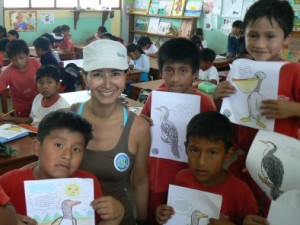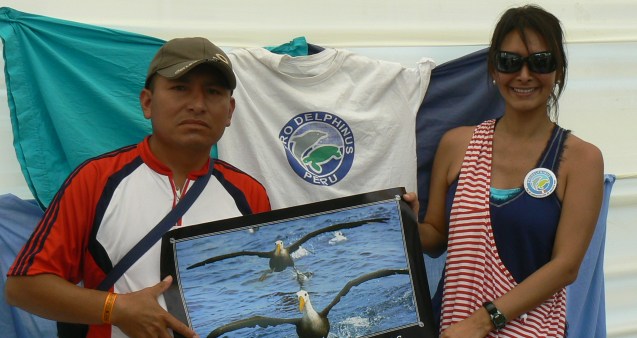A life on the ocean waves
Joanna Alfaro, November 2011
Most conservationists will tell you about how they were first inspired to work in conservation. Perhaps it was a conversation with a family member, something seen on TV or an encounter with a wild animal. Joanna Alfaro clearly recalls the day when she became interested in the natural world. Her dad came home from work carrying a big dictionary crammed with new words to learn and practice. Like most curious kids, Joanna thumbed straight to the picture pages and her eyes fell upon vivid images of dazzling birds of paradise. The book, combined with her love of the outdoors proved to be the inspiration for a successful conservation career to date.
Today, it' s not birds of paradise but sea birds which receive Joanna' s attention and she is still enthralled by the numbers which she encounters in remote islands.
'Island trips are awesome.' Joanna says enthusiastically. 'I guess Guano Islands are the most remote places along Peru's coastline. They hold exciting, interesting and unusual fauna. The size of Guano bird populations on the islands is overwhelming there can be as many as 200,000 birds all bunched together - and when they are all grouped, giant flocks can form and are a breath-taking picture. I simply love it!'
It was whilst researching the amazing long-distance migratory routes of birds visiting Peru from as far as Australia and New Zealand that a group of Uruguayan biologists told her about the Conservation Leadership Programme (CLP).
Stretching along 3,000km, Peru' s coastline coast line offers important habitats to many threatened species of birds, mammals, reptiles and plants. Next to the vast greys and blues of the Pacific ocean, the desert landscape is a stark and beautiful contrast - something that attracts Joanna to working here as President of Peruvian NGO Pro Delphinus. She is also completing a PhD at the University of Exeter in the UK.
'Our work focus on fisheries impacts to biodiversity, known as bycatch. In many cases, bycatch includes marine turtles, seabirds, marine mammals such as whales, dolphins or porpoises and it' s having a detrimental impact on populations.'
As a result of their first CLP-funded project in 2005, the team identified a local interest in seabird conservation which they promoted through work with students, researchers and local government officers. Their research found important information about the critically endangered waved albatross (Phoebastria irrorata) which breeds on the Galapagos Islands and uses Peru as a foraging ground. One of Joanna' s most memorable moments came during a boat trip to research waved albatross abundance. Given the threatened status of albatross, they had only been expecting to see a few birds. Instead, a few miles out to sea, they came a cross a group of 80 albatrosses floating on the water!
'It was a gorgeous scene' recalls Joanna. 'Boat trips are always exciting. Being exposed to a totally different environment, finding yourself in a wide open seascape, where your only base is your small island of a boat.'
 As a Follow-up project in 2007, the team developed closer links with fishing communities and recruited fishermen ambassadors to start spreading the message about fishing techniques which do not place threatened species at risk. Now in their third and final term of CLP funding, the team has gone through a few changes in personnel but there are close bonds and continued communication between team members: something key to maintaining successful teams and ensuring successful completion of projects.
As a Follow-up project in 2007, the team developed closer links with fishing communities and recruited fishermen ambassadors to start spreading the message about fishing techniques which do not place threatened species at risk. Now in their third and final term of CLP funding, the team has gone through a few changes in personnel but there are close bonds and continued communication between team members: something key to maintaining successful teams and ensuring successful completion of projects.
'Everyone involved in these projects maintains close bonds and we always have things to share about the projects with which we are involved.'
Being part of the CLP alumni network has given Joanna and her team opportunities which go beyond the experience of implementing a practical conservation project as Joanna explains.
'Some of us have received CLP training, attended workshops and conferences useful for their careers; others found more inspiration for their jobs thanks to the network established with other CLP alumni or staff. All these connections and research and training opportunities have helped make me better at what I do, have improved our work, and served global conservation efforts.'
Having been inspired by birds and the sea, and by her fellow conservationists, Joanna is now doing her bit to provide inspiration and advice to others. One piece of advice she offers is to keep one' s ears open to opportunities.
'People say that it is important to listen. I agree. I have learnt a lot by listening to other people' s experiences.'
As an experienced alumna, Joanna is keen to offer her services as a mentor to other CLP alumni. If you are member if the CLP alumni network and are interested in learning from Joanna' s experience first hand please contact the CLP and state your interest in the CLP Learning Exchange Programme.





